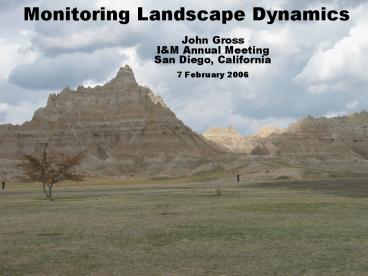Monitoring Landscape Dynamics - PowerPoint PPT Presentation
1 / 25
Title:
Monitoring Landscape Dynamics
Description:
Phenology (plants, ice, permafrost) Topography (coasts, reefs, etc) ... Tropic structure. Type of effect. Human density. Human activity. Exotics / disease ... – PowerPoint PPT presentation
Number of Views:161
Avg rating:3.0/5.0
Title: Monitoring Landscape Dynamics
1
Monitoring Landscape Dynamics
- John Gross
- IM Annual Meeting
- San Diego, California
- 7 February 2006
2
- IM / NPS Highlights
- Lessons
- Into the future
3
Highlight 1 Look what were doing!!!
4
Quality, quantity, breadth, relevance
- Disturbance
- Vegetation change
- Land condition
- Phenology (plants, ice, permafrost)
- Topography (coasts, reefs, etc)
- Pattern and context
5
Programmatic Goals
- Wise choices
- Consistency
- Efficiency
- Institutional learning
6
Shared learning among IM Networks and
collaborators
Cohen, Kennedy NCCN, SWAN, NCPN, SCPN Townsend
APHN, NCRN Reed SWAN, NCPN, SCPN Wang
NETN, NCBN Hansen HTLN, GRYN Brock GULN,
SFCN, SECN, NCBN
7
With External Partners
- Workshop NASA, PCA, CCRS, CSA, NPS
- Ecosystem modeling NASA (SIEN YOSE)
- NASA internship program (SIEN, Fire, USFS)
- NASA Proposals and grants
- Invasive species fire (Welch, Paintner, Benson,
Morrisette) - Monitoring proposal (Hansen et al.)
- Land use and climate effects on biodiversity in
70 large parks (Hansen Running) - Park Science paper IM and NASA (Turner,
Nemani, Gross) - National Phenological Network
- Heinz Center terrestrial and coastal groups
NDMI, 1989 to 2004
8
Networks and Landscape Dynamics
- Draft protocols
- NCCN
- GRYN
- NCRN
Bandelier National Monument March 4, 1999
9
- NCCN Protocol Warren Cohen and Robert Kennedy
- Very large and remote parks
- Landsat focus cheap, consistent, historical,
good near short-wave - Track changes in broad physiognomic classes
- Many changes described as proportional mixture
changes
10
- NCCN Protocol Warren Cohen and Robert Kennedy
- Very large and remote parks
- Landsat is core of effort
- Cheap, consistent, historical, good near
short-wave sensor - Track changes in broad physiognomic classes
- Many changes described as proportional mixture
changes - Multi-tiered validation approach
- Focus on pixel-based products
- Solid foundation for post-map analysis
- Facilitate patch or super-pixel pattern analyses
11
- GRYN Protocol Hansen / Jones
- Large area
- Land use intensification in critical habitats
- Excellent conceptual models linking landscape
change to resources - Extensive use of remotely sensed and ancillary
data
12
Linking landscape change to park resources
(modified from Hansen and DeFries in prep)
13
Public data
Plus roads, lights, imagery archives
(modified from Hansen and Gryskiewicz 2003)
14
NCRN Protocol Townsend, Gardner, Lookingbill
- Many small parks in rapidly urbanizing landscape
- Effects of imagery resolution
- Pattern analysis based on graph theory
- Comprehensive testing and review of protocol
(Figure Townsend et al. draft protocol)
15
Lessons leaned
- Many opportunities for broad-scale analyses
- Core vital signs,
- Major potential to use inexpensive,
widely-available data, - Change detection - use of inexpensive
high-frequency, coarse-resolution data to
strategically acquire expensive data, - Scale of objectives consistent with USGS, EPA,
NOAA, PCA, - Potential for program-wide efficiencies in data
processing and analysis, - Potential collaborations at local to
international scales.
16
- Finer-scale landscape dynamics (often vegetation
change) - Partnership opportunities at regional, network or
biome scale - Many more network- or park-specific issues
- Change detection is a very big issue (resolution,
cost)
17
Parks Canada Approach
- Large collaborative project with limited set of
objectives - Habitat fragmentation / pattern
- Vegetation succession / retrogression
- Vegetation productivity
- Biodiversity (species richness)
Lesson
Efficiencies from a highly focused group with
clearly objectives. Very rapid progress and
consistency.
Agencies PCA, CCRS, CSA, Universities
18
Whats on the horizon?
How can we best monitor linear park units?
NETN, GLKN, HTLN Appalachian Trail river-based
parks
19
Whats in the future
Emergence of a National Phenological Network
- Seasonal changes are one of the most pervasive
environmental variations on Earth - Effects seen in agriculture, transportation,
health, hydrology, etc. - Direct link between monitoring results and
broader social values - http//www.uwm.edu/Dept/Geography/npn/
20
Why we want a National Phenological Network
- Priority vital sign for multiple networks,
- Standardized protocols,
- Ability to use and contribute to broader context,
- Leverage activities by others,
- Excellent means to link and add value to other
measures.
Implementation team meeting March 22-23,
2006 Involves USGS, USFS, EPA, NOAA, NASA, NPS,
universities
21
Whats in the future
Greater use of ecosystem modeling for monitoring
and management
- Rama Nemani, NASA Ames Terrestrial Observation
and Prediction System (TOPS). - Current link to NASA internship program
- Pilot project with SIEN Yosemite NP
- Hope to expand to Island Royale
- Educational process
http//ecocast.arc.nasa.gov/
(figure from http//ecocast.arc.nasa.gov/)
22
Whats in the future
Coordinated acquisition of regional to national
data?
- Focus on broad-scale data sets
- Land cover, roads, population, agricultural
records, pollution, etc. - Linkages to MRLC, Landfire
- Consistent evaluation, system-wide context
MRLC land cover zones
23
Landscape Dynamics Breakout Session focus on
partnerships
Landfire and how its going to help us Dr.
Kevin Ryan, USFS Parks Canadas approach Dr.
Donald McLennan NASA DEVELOP interns, NPN,
modeling John Gross
24
Selected Resources
- Landscape dynamics
- Landscape dynamics web site http//science.nps.go
v/im/monitor/lulc/LULC.cfm - NASA TOPS - http//ecocast.arc.nasa.gov/
- NASA DEVELOP Internship program -
http//develop.larc.nasa.gov/ - Phenology and climate change
- National Phenological Network -
http//www.uwm.edu/Dept/Geography/npn/ - European Phenological Network -
http//www.dow.wau.nl/msa/epn/index.asp - Pacific West Region Climate Change Page -
http//inside.nps.gov/regions/region.cfm?rgn223
lv3
John Gross 970 267-2111, johng_gross_at_nps.gov
25
http//science.nature.nps.gov/im/monitor
Remote Sensing and Landscape Dynamics































